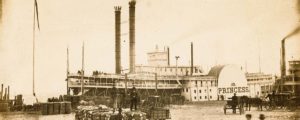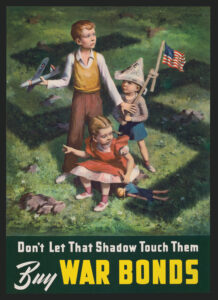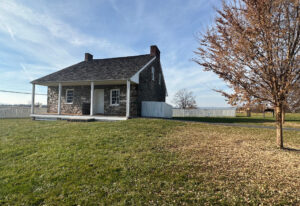America was an unrivaled paradise with rivers full of fish and forests full of game. Even the much-feared natives weren’t so savage. Yet within a year, more than half the colonists at Plymouth, Jamestown, and perhaps Roanoke, were dead.
B y 1640, just 20 years after 101 souls on the into Cape Cod Bay, America Mayflower sailed was no longer in question. From 1630 to 1640, more than 20,000 people and unnumbered livestock had emigrated from England to the New World, sailing in some 200 ships like the Plough of Woolwich, the Ark and the Dove. Boston had been founded, and so had a seminary—Harvard. Settlers came as families and individuals. They came in single vessels and in convoys like the 11 ships assembled by John Winthrop, which sailed for Salem in 1630 carrying 700 people. Yet Winthrop’s ships alone carried more than the total number of English settlers who had come to all of America in the preceding 45 years, an indication of just how difficult mere survival in the new land had been until then. Most settlers died within months of landing, as did 52 people aboard the Mayflower. In Virginia, all 127 members of the first Roanoke settlement in 1587 simply vanished. In Jamestown, 66 of the first 104 settlers died within a year of landing in 1607, and another 440 followed them to the grave by 1610. Founding a settlement that survived in America was as hard as starting a fire in the freezing, rain-drenched woods of that first Plymouth winter.
And yet this environment was an unrivaled paradise. Plymouth, one of its first settlers wrote, “is a most hopeful place,” containing “innumerable store of fowl,” skate, cod, turbot and herring, “abundance of mussels the greatest and best that ever we saw; crabs and lobsters, in their time infinite.” Whales lay basking in the bay, and it was impossible not to speculate on the profits to be made by whaling, if only the settlers had the proper gear. The soil was good, the prospects overwhelming. Early writers like Thomas Hariot described the richness of America as if taking inventory in an alien warehouse. And, as environmental historian William Cronon notes, the timber alone would have astonished the English, whose homeland had been nearly denuded of woodland.
There were other advantages too. The Mayflower Pilgrims, when they chose a site for their settlement, found open ground already prepared for the corn seed they had discovered buried beneath the sand on Cape Cod—“God’s good providence.” The cleared ground had really been prepared by a plague that devastated the American Indian population in 1616, leaving the village of Patuxet—now Plymouth—empty, “so as there is none to hinder our possession, or to lay claim unto it,” as Mourt’s Relation, a chronicle of the colony’s first year, put it.
All of this raises a fundamental question. Why was colonizing America so hard at the start? Why was it so difficult to found a permanent settlement in the 16th and early 17th centuries when natural abundance was so great? Or do the difficulties of those early settlements—judged against the harsh conditions of life in places like London or Leiden—appear mainly in our eyes as we look back over the centuries to a country largely of our imagining?
Some answers present themselves immediately. Jamestown was founded in the midst of a long drought. Scurvy, dysentery and other diseases took a swift toll, concealing the fact that the climate of New England would prove healthier in the long run than Virginia or London. Perhaps most important, these early missions were grievously undersupplied, and when new ships and settlers arrived at last, they too were grievously undersupplied and those aboard expected to be fed by their predecessors.
Still, none of these first enterprises failed through informality or spontaneity. The settlers sailed under patent and license, under the authority of king, queen or company, with the expectation that goods like beaver pelts soon would be sent back, yielding profits far exceeding the considerable expense of the journey. The spiritual voyage of the Separatists we’ve come to call Pilgrims was equally an economic enterprise, a sort of joint stock company with property in the New World scheduled to be divided up by participants after seven years. For the first few years the colony was run as a commune with everything owned jointly. The colonists were backed by a small group of investors who were becoming increasingly disgruntled by the return of ships from the New World carrying next to nothing. By 1626, the colony had failed to return the profits its investors expected and so was forced to restructure its debt, arranging, in a sense, to buy back its own assets in America over nine years.
As Jared Diamond writes in Collapse, this sad history of failed settlements “shows how long were the odds that those attempts faced, even for colonies backed by Europe’s wealthiest and most populous nations, sending annual fleets of ships…and equipped with guns and abundant iron tools.” That is the inherent strangeness of the story of early European settlements in America. Europeans set forth with what they believed was a profound cultural and technical advantage over the native inhabitants of the Americas, who, they came to discover, enjoyed a vastly superior understanding of how to live in the New World.
No one expected it to be easy. “The dangers were great, but not desperate; the difficulties were many, but not invincible,” wrote William Bradford, the leader of Plymouth Colony. But these are the optimistic words of a man writing in retrospect, a man who had already survived the voyage from England and the diseases that killed half of his fellow passengers during their first winter in the New World.
The dangers were perfectly clear even as the project was being discussed in Leiden, where the Separatists first took refuge from religious persecution in England. They feared “the casualties of the seas” and “the miseries of the land.” And in their discussions they produced a comprehensive list of the problems that might afflict their enterprise: the effect of the sea voyage on women and the elderly, the consequences of a change in air, diet and water, the cost of the ship and the necessary supplies, as well as the difficulty of being re-supplied. Above all, they feared America’s native occupants—the Indians John Smith called “naturals”—and the savagery of a land devoid, as Bradford put it, “of all civil inhabitants.” Add to these things the pain of separation from everything familiar, the loss of friends, family and a culture left behind.
Theirs was a stark, realistic appraisal. There was nothing blithe about their assumptions, no matter how well they were girded with religious faith. “Friend,” wrote one of the passengers during the long delays before setting out, “if we ever make a plantation, God works a miracle; especially considering how scant we shall be of victuals, and un-united amongst ourselves.”
From our perspective, the difficulty the Pilgrims faced seems almost self-explanatory, especially if we imagine ourselves in their places. They sailed very late in the year, and without the second, smaller ship—the Speedwell—that was supposed to accompany them. They spent nine weeks at sea, part of it under bare masts waiting out fierce winds and “a mighty storm,” in an unimaginably crowded ship. And they arrived on the New England coast in late November in an era when winters were much more severe than they are now. After landing, as Bradford wrote, “they had no friends to welcome them, nor inns to entertain or refresh their weather-beaten bodies, no houses or much less towns to repair to, to seek for succor.” They were far more skilled at theological thinking than living off the land.
It’s hard now to imagine the mixture of relief and dismay the Pilgrims must have felt upon landing far north of their original goal, the Hudson River. Something about that first landfall—the sighting of Cape Cod and the rounding into its bay—reminds us how far away in time 1620 really is and how early this venture was, chronologically speaking. The 1620 in which the Pilgrims landed seems very different than the 1620 being experienced in England and on the Continent. The Pilgrims have been absorbed into our history—they belong, in that sense, to the future. But this was still a time when the most advanced human artifact, technologically speaking, was a larger version of the craft they sailed in, a craft, it’s worth remembering, that was only 90 feet long, no more than 26 feet wide, and navigated by compass and cross-staff.
To wonder why the Pilgrims succeeded, consider the failures they managed to avoid. Some are easy to name. Half the settlers died during that first winter but—cruel as it seems—only half. More would surely have died, including William Bradford and Edward Winslow, two of the most important colonists, without the good health and constant care of six or seven of their company who never fell ill, among them Miles Standish, a hired military adviser who played a critical role in the history of the settlement—none more important than during that first winter. Had even a few more people perished, Plymouth might well have been one of the lost colonies, too.
Whether the plantation succeeded or failed depended on a simple but dire question of logistics. The Mayflower had to carry enough food to feed passengers and crew on the 66-day voyage out, to feed the new settlement for as long as possible once they reached America, and to feed the crew on the return voyage. This was cutting it fine, in part because the passengers and the hired crew of the Mayflower had very different interests. “Whilst we had competent victuals,” one writer noted, “the ship would stay with us, but when that grew low, they would be gone and let us shift as we could.”
The Mayflower’s master, Christopher Jones, would have rushed to disembark his passengers, once they found a place to settle, except that his crew was felled by illness too. When he departed at last, on April 5, the Pilgrims were left, as one writer put it in 1621, “with very small means.” We don’t know the conditions aboard the Mayflower when it reached England in mid-May of 1621, but it may very well have resembled those aboard Bartholomew Gosnold’s ship, the Concord, upon its return to England in 1602, after giving up an attempt to establish a settlement on Cuttyhunk Island. By the time Gosnold anchored in England, “we had not one cake of bread, nor any drink, but a little vinegar.”
A great deal of imagination has been expended on the landing of the Pilgrims but very little on the day of April 5, 1621, when the Mayflower worked its way out of Plymouth Harbor and up the shoals of the bay, homeward bound. Left behind was a thinned, weakened band of settlers, with only the most rudimentary shelter, performing labor of a kind that most of them were not used to—building two rows of houses near the common house they had wintered in, a building of 20 feet square. This is one of the moments—there are several—when the historical singularity of the Plymouth Colony becomes evident. It requires a two-fold exercise in imaginary history.
If the American continent had been as virginal as Europeans often imagined it was— a wilderness truly unpeopled—the Plymouth colonists, equipped only with English seeds, having to create fields out of scrub and woodland, having to live mainly on what they found in the wild, would surely have died before they could be resupplied. And if the Pilgrims had landed among healthy native villages, it’s unlikely they would have been able to follow the two most important instructions John Smith wrote out for Bartholomew Gosnold: “In all your passages you must have great care not to offend the naturals” and “use and endeavour to store yourselves of the country corn.” This was essential and contradictory advice.
In a single sentence, William Bradford summarized his notion of the difference between the Pilgrims—and, implicitly, all European settlers—and the Indians they encountered. He said, simply, “they were only savage and brutish men, which range up and down, little otherwise than the wild beasts.” The Pilgrims, instead of roaming like the Indians, made a fixed abode on the model of an English village—a fixed abode that would have to defy the seasons. What Bradford did not grasp was why the Indians ranged “up and down.” The natural wealth of the New World was seasonal. Fish were not always running up the rivers in immense numbers. Deer were not always fat, and berries were not always in season. The restlessness Bradford scorned was, in fact, the only practical way to live directly on the abundance of nature.
What fed the Pilgrims—what saved the Pilgrims—was the fact that many of the Indians they encountered had learned to soften the fluctuations of seasonal richness by staying in one place long enough to plant corn and wait until those fields had given up their fertility. The well-known story of Squanto— who had learned English in London—teaching the Pilgrims to plant fish with their corn stems from a simple fact: They were planting on exhausted fields.
We tend to look back on that corn as a primitive version of what we grow now. But we are looking through the wrong end of the telescope. What the Wampanoag and other eastern tribes were growing was distant from the ancestral origins of corn from Mexico. The corn the Pilgrims found buried in caches and began to grow themselves was the result of several thousand years of trade and careful selection. Its yields—the number of seeds each ear could produce—were far greater than that of any plant the English carried with them.
Those first American settlements in Virginia and Massachusetts resemble a swimmer crossing a swollen river with a rope in his hand. He may be swept away, but if he makes it to the far side, the rope can be tightened across the current making it easier for everyone else to cross. The distance between 1620 and 1630 is immense. It is more than the difference between the solitary Mayflower carrying a hundred people and Winthrop’s 11 ships carrying 700. There is something expeditionary in those first settlements—a willingness to take an overwhelming risk, trusting to God—and chance—to make all the difference. From the vantage of 1630, not to mention 1640, the passengers aboard the Mayflower look as though they were a timeless message in a bottle adrift on the Atlantic, sealed away in spiritual zeal from the world around them, almost alone on the water.
But in the great migration to New England during the decade between 1630 and 1640, you can feel enormous social, economic and political pressures driving settlers—gentlemen, laborers, artisans, families—to America in numbers that made success inevitable. For many reasons—among them growing civil unrest in England—the English were on the move in astonishing numbers during that decade, some 20,000 of them sailing for New England. Yet as historian Bernard Bailyn notes, three times as many “left England for other colonies in America and the West Indies, and almost six times that number of Englishmen and Scots (120,000) migrated to Ireland.”
Against that backdrop, there is something dismaying about the thought of a solitary ship carrying only a hundred people landing in wintry New England or Tidewater Virginia with no chance of resupply for many months to come. It’s tempting to say that the settlers had only themselves to depend on, except it wasn’t true. They did have the natural richness of America and, in the north, the unrewarded friendship of the very people they were displacing, the people Bradford had feared as “cruel, barbarous, and most treacherous, being most furious in their rage.” By 1620, French explorer Samuel de Champlain had been to Plymouth, as had Jamestown’s Captain John Smith. There had been nearly a century of fishing and fur trading along America’s coast. It was “a largely unrecorded trade,” writes Cronon, but it taught American Indians a great deal about Europeans—including their languages—before the settlement ships arrived in all their ignorance.
Providence was a two-edged sword. European diseases decimated the native inhabitants of eastern America, and yet those earliest settlements could never have survived without native friendship and knowledge. In 1639, William Wood, describing his impressions of New England Indians, confessed that it was impossible “to recount the courtesies they have showed the English since their first arrival in those parts.” But if he had the power to describe those courtesies, Wood wrote, “it would not only steady belief that they are a loving people, but also win the love of those that never saw them.”
Verlyn Klinkenborg is on the editorial board of the New York Times and the author of The Rural Life.
Originally published in the December 2011 issue of American History. To subscribe, click here.




